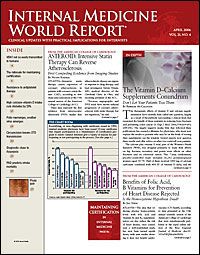Publication
Article
State-of-the-Art Technology for Stroke Diagnosis UnderusedNoncontrast CT Still Often Used When CT Angiogram Is Needed
Author(s):
MIAMI—Primary care physicians should be sure they send their aging stroke patients to a primary stroke care center that uses up-to-date imaging technology to ensure accurate diagnosis, which is so vitally important for the proper management of stroke and the prevention of irreversible neurologic damage.
At the 18th annual International Symposium on Endovascular Therapy, Kevin J. Abrams, MD, medical director of neuroradiology and magnetic resonance imaging (MRI), Baptist Hospital and Neuroscience Center of Miami, emphasized that accurate, prompt diagnosis and immediate treatment are of vital importance for stroke patients, because neurologic dysfunction occurs after cerebral blood flow falls below 18 to 20 mL/100 g of tissue per minute.
Dr Abrams lamented that imaging techniques available today for diagnosing acute stroke are not used by most institutions. For years, acute stroke patients have been diagnosed only with computed tomography (CT). The literature is full of trials about patients visiting emergency departments and undergoing noncontrast CT of the brain. This, however, is no longer adequate.
Although this remains the standard of care in most US hospitals, it is no longer the case at his hospital, he told IMWR. “We’ve adopted a multimodal CT approach to brain imaging in the acute stroke patient. We begin with a noncontrast brain CT scan, because it is important to rule out bleeding or other processes that may mimic a stroke. Then, if the patient is a candidate for stroke thrombolysis, we will do a CT angiogram.”
CT angiography starts with an intravenous injection of a bolus contrast and an examination of sections of the blood vessels to see what is going on. This is followed by an injection of additional contrast fluid to determine how well the blood is flowing to different parts of the brain. If there is an area that is relatively ischemic, the CT angiogram is checked to see if the area is the same as the defect in the blood vessels. Cerebral blood flow of <10 mL/100 g of tissue per minute cannot be tolerated beyond a few minutes before infarction occurs.
“This gives us a better idea of which patients to treat and how to treat them,” said Dr Abrams. Currently “there are not many treatment options in the armamentarium…. Some patients who have been reperfused have seen their perfusion defect re?verse, and there is no reason to treat those patients at that time,” he said.
About 1 stroke out of 5 is an acute hemorrhage, which can be stratified with noncontrast imaging into 1 of 2 different stroke types. Large hemorrhages are frequently due to hypertensive strokes, in which case thrombolysis is not an option. On the other hand, subarachnoid hemorrhage can be treated with coiling or clipping of the aneurysm.
“In our institution we do a CT angiogram on any patient who comes in with an acute subarachnoid hemorrhage to search for an aneurysm. This is useful to give the neurosurgeon an idea if there is an aneurysm, and where it is,” Dr Abrams explained. “We’ve had in?stances where the patient came in with a ruptured aneurysm and a concomitant large subdural hematoma, herniating, and there was no time to do a conventional arteriogram. So while they are on the table, we do a CT angiogram, and the patient goes right to the operating room for a decompression of the hematoma and clipping off their aneurysm.”
Management of acute stroke is best performed by a team in which there is good communication between all in?volved, according to Dr Abrams. “Multimodal CT and MRI are here and will be more prevalent when future studies show us how to use the ?information we are getting to best advantage…. The technology is rapidly changing; the state of the art is really the state of the moment,” he said.






